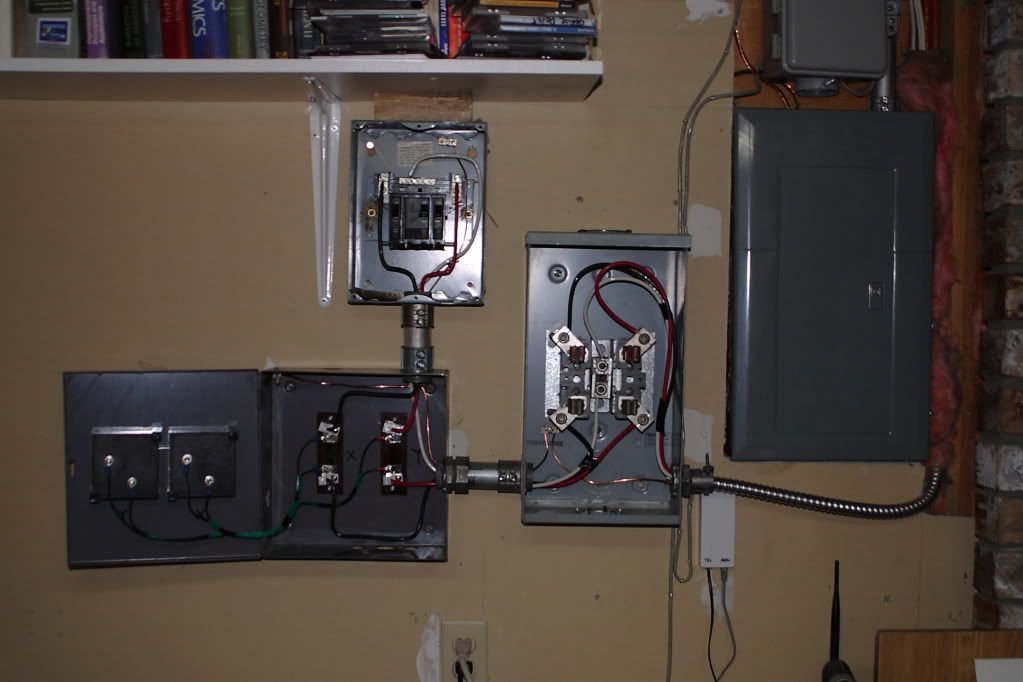Re: Ammeter Setup not Behaving
Are the shunts made for the Amp-meter? Do you have the spec for the Amp meter that should tell you what kind/value of shunts can be used with the meter. 75mV @50A is not even enough to bias on the Diode. Spec of the meters?
Ammeter Setup not Behaving
Collapse
X
-
Ammeter Setup not Behaving
For those who did not follow the other thread, I installed a 240V 40A branch panel in the house and for monitoring purposes I also installed a standard 200A KWH meter and two 50A 75mv shunt driven ammeters.



For testing I'm using a 120v 1500w space heater which according to the formula should mean a 12.5A load. The problem is that the (appropriate) ammeter isn't reading anything at all. Even adding a 1200w toaster oven didn't budge the needle. I ended up having to drag out a vacuum cleaner to see the needle nudge up one amp during startup.
Not sure if the shunt configuration is not correct or I'm not properly load testing the system. With the racks and home theatere not yet installed I don't have half a dozen servers to load the system. Only random appliances around the house.Tags: None
Related Topics
Collapse
-
This specification for the Acer ConceptD CN715-71P-75MV Notebook can be useful for upgrading or repairing a laptop that is not working. As a community we are working through our specifications to add valuable data like the CN715-71P-75MV boardview and CN715-71P-75MV schematic. Our users have donated over 1 million documents which are being added to the site. This page will be updated soon with additional information. Alternatively you can request additional help from our users directly on the relevant badcaps forum. Please note that we offer no warranties that any specification, datasheet, or...09-06-2024, 02:30 PM
-
by caspianDear Members,
My DC linear Lab Power Supply does not display the current and voltage correctly. Thus, I am going to connect an Ammeter/Voltmeter Module to the DC output of the power supply. Then, a load will be connected the takes about 1-5volts with 0.1-1.5Amps.
But I heard If I connect an Ammeter to the output of the power supply, then the Ammeter module is not isolated from the power supply so that the Ammeter can damage the power supply.
Is this true?
Thanks
I have attached the photo of a sample Ammeter module that I am going to buy.... -
by caspianDear Members,
I have an old analog voltmeter that can correctly measure DC voltage between 0v to 3v. The voltmeter is made by Toyokeiki depicted in the photos. It does not need any battery. It works using a coil and a magnet as any other analog voltmeters.
I am going to convert this voltmeter into a DC ammeter that can measure DC current between 0A to 15A.
To do this, I use a 0.2 Ohm resistor for current sensing in the circuit. Then, I use the setup depicted in the photo to measure current.
For example, if the power be 12v and the load be 8 ohms, the voltmeter shows... -
by hervouHi all,
I'm becoming crazy trying to fix the Philips TV of my old man (model 43PUS6201/12 - the TV, not my dad). I've read again and again discussions about this and similar TV models, on badcaps (thanks so much !). I see no other option than asking for your help.
The symptom is simple : when I plug the power cord, the red "stand-by" LED does not light on anymore, and the TV powers-on neither with the remote control nor with the rear button. I guess at this point you immediately think at the 5V (or other voltage depending on the hardware) stand-by output......3 Photos -
by Comp_ProHello all,
I have this 820-01700 board which came in with 5V 0.015A on the ammeter. Ammeter cycles every 5 seconds or so. Upon inspection I found PPBUS_G3H is reading around 0.6V. There is no short to ground. Diode mode reading is about 0.420V. When I remove fuses F7000 and F7001 the U700 side of the circuit produces 12.3V and the cycling goes away on the ammeter but still stays at 5V and now reads 0A. This goes away as soon as I put back the fuses. I tried injecting voltage onto the system side of the fuse pads but I do not get any current draw at all. I tried seeing if the voltage... - Loading...
- No more items.
Leave a comment: